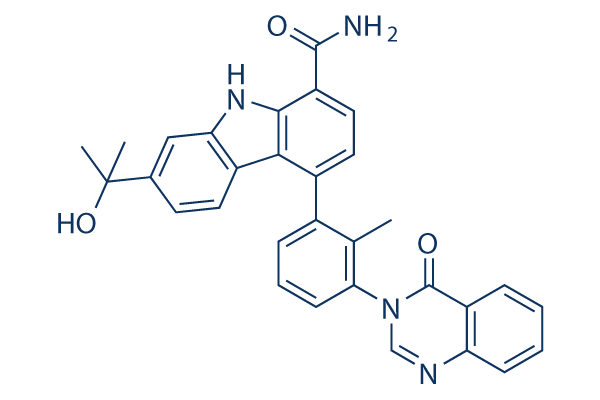All AbMole products are for research use only, cannot be used for human consumption.

In vitro: BMS-935177 shows greater than 50-fold selectivity over the SRC family of kinases, including 1100-fold selectivity over SRC itself. Other kinases inhibited with a potency less than 150 nM (50-fold selectivity) included TRKA, HER4, TRKB, and RET. It inhibits calcium flux in human Ramos B cells (IC50 = 27 nM) and inhibits CD69 surface expression in peripheral B cells stimulated with anti-IgM and anti-IgG. However, BMS-935177 has no effect on CD69 surface expression in B cells stimulated through the CD40 receptor with CD40 ligand. Against IgG-containing immune complex-driven low affinity activating Fcγ receptor (FcγRIIa and FcγRIII) end points in peripheral blood mononuclear cells (PBMCs), BMS-935177 effectively inhibited TNFα production with an IC50 value of 14 nM.
In vivo: Plasma protein binding for BMS-935177 is high for all species, with less than 1% free for human. It has excellent oral bioavailability in all preclinical species, from both suspension and solution dosing, despite its low aqueous solubility. The oral bioavailability for BMS-935177 with solution dosing ranges from 84% to 100% in rat, mouse, dog, and cynomolgus monkey, with low clearance in single intravenous (iv) infusion studies. When dosed at 2 mg/kg i.v. in mouse and rat, the T1/2 of BMS-935177 is 4 h and 5.1 h respectively.
| Cell Experiment | |
|---|---|
| Cell lines | |
| Preparation method | |
| Concentrations | |
| Incubation time | |
| Animal Experiment | |
|---|---|
| Animal models | Male Sprague−Dawley rats |
| Formulation | polyethylene glycol 400 (PEG-400)/water/ethanol (70:20:10, v/v/v) solution |
| Dosages | 2 mg/kg |
| Administration | i.v. |
| Molecular Weight | 502.56 |
| Formula | C31H26N4O3 |
| CAS Number | 1231889-53-4 |
| Solubility (25°C) | 100 mg/mL in DMSO |
| Storage |
Powder -20°C 3 years ; 4°C 2 years In solvent -80°C 6 months ; -20°C 1 month |
| Related BTK Products |
|---|
| BIIB129
BIIB129 is a covalent, selective inhibitor of Bruton's tyrosine kinase (BTK) capable of penetrating the blood-brain barrier. BIIB129 inhibits the activity of BTK by covalently binding to Cys481 in BTK, thereby affecting the function of B cells and myeloid cells. |
| UBX-382
UBX-382 is an orally available proteolysis-targeting chimeras (PROTACs) that target BTK to inactivate B-cell receptor signaling. |
| GDC-0834
GDC-0834 is a potent and selective BTK inhibitor. |
| DD-03-171
DD-03-171 is a BTK, IKFZ1 and IKFZ3 degrader, the BTK IC50 a value of 5.1 nM. |
| N-piperidine Ibrutinib hydrochloride
N-piperidine Ibrutinib hydrochloride is a reversible Ibrutinib derivative. |
All AbMole products are for research use only, cannot be used for human consumption or veterinary use. We do not provide products or services to individuals. Please comply with the intended use and do not use AbMole products for any other purpose.


Products are for research use only. Not for human use. We do not sell to patients.
© Copyright 2010-2024 AbMole BioScience. All Rights Reserved.
